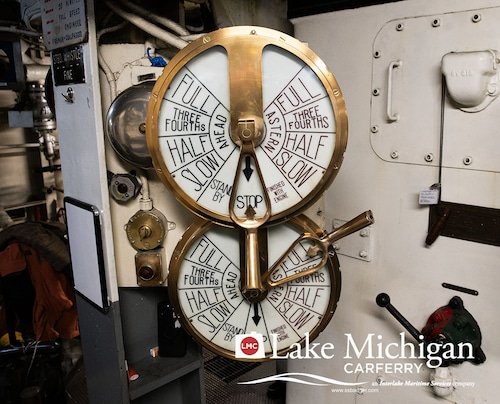LUDINGTON, MI – This historic ship that operates a ferry route across Lake Michigan still uses 1850s technology.
The captain of the S.S. Badger uses the then-revolutionary Chadburn engine order telegraph, or EOT, to send orders from the aft pilot house to the ship’s engine room during docking. The EOTs are original to the ship.
“During this procedure, a series of maritime music occurs as a variety of bells chime from the EOT indicating various communication back and forth between the captain and the engineers,” Badger officials said on Facebook.
RELAED: Enhanced culinary experience coming to 4-hour ferry trips across Lake Michigan
In the engine room, two engineers monitor the EOTs. One controls the starboard engines while the other controls the portside. An oiler keeps watch on the instruments.
The Badger’s EOTs were installed when the 410-foot ship was built in 1952.
The captain of the S.S. Badger car ferry still uses engine order telegraphs to send orders to the engine room. The Chadburns are original to the ship’s 1952 construction.Lake Michigan Carferry
The Chadburns “continue to be used as a primary source of communications,” aboard the ship, the post said.
RELATED: Book now to cross Lake Michigan on this historic car ferry in 2025
The EOT was invented by Charles Grafton Page to quickly transmit speed and direction orders to the engineers in the engine room, improving navigation safety and efficiency.
Page, an engineer and doctor, began experimenting with electricity while he was a student at Harvard College. Aside from the EOT, his experiments led to the invention of the induction coil and was cited by Alexander Graham Bell as an important precedent to the invention of the telephone.
RELATED: Last coal-powered car ferry in the U.S. marks 72nd anniversary on Lake Michigan
The EOTs on board the Badger were manufactured by Chadburn’s Limited of Liverpool, England, which is why they are often referred to as “Chadburns.” Chadburn and its predecessor companies were responsible for 75 percent of the world’s marine telegraph production.

The S.S. Badger docks in Ludington on Sunday, July 7, as crews work on an electrical repair. The problem arose during a crossing from Manitowoc, Wis., to Ludington on Saturday afternoon. Eight Lake Michigan crossings have been canceled. Service is expected to resume on Tuesday, July 9.Garret Ellison |gellison@mlive.com
The coal-powered car ferry, the last of its kind on the Great Lakes, was named a National Historic Landmark in 2016.
RELATED: 1950s summer employee welcomed by S.S. Badger captain during Lake Michigan trip
Originally used to transport railcars across the Lake Michigan, Badger now operates an extension of U.S. 10 carrying passengers and vehicles between Ludington and Manitowoc, Wis. The 60-mile trip takes about four hours.
The S.S. Badger operates from May to October; the 2025 season begins on May 16. It can accommodate 600 passengers and 180 vehicles, including cars, trucks, vans, SUVs, campers, RVs, motorcycles, motorcoaches, commercial trucks, oversized loads, bicycles, trailers and more.











